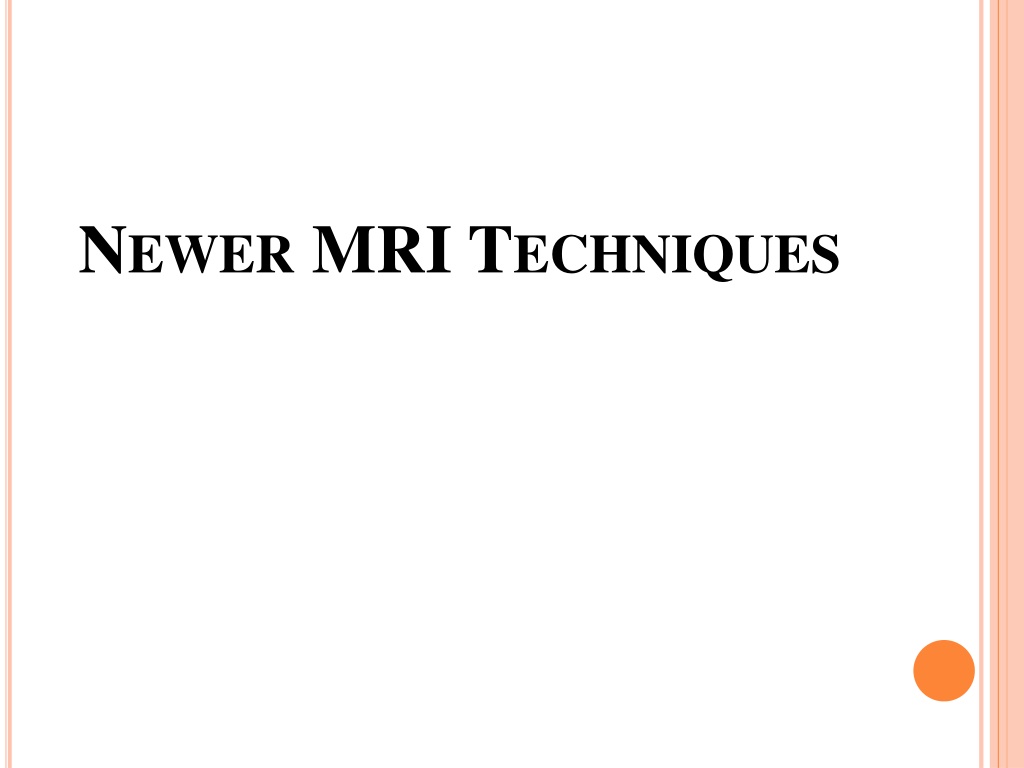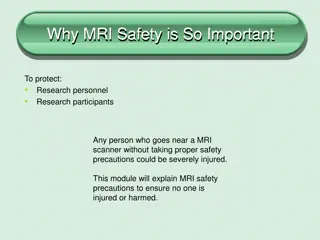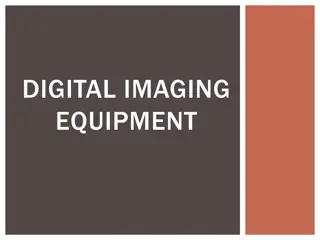Understanding Magnetic Resonance Imaging (MRI)
Magnetic Resonance Imaging (MRI) is an imaging technique based on nuclear magnetic resonance principles. It was first developed in the 1970s by Paul Lauterbur and Peter Mansfield. MRI uses the interaction between protons in the body and magnetic fields to create detailed images. This technology has evolved over the years, moving from NMRI to MRI. The process involves placing the object in a magnetic field, exposing it to pulses of electromagnetic energy, and capturing signals for imaging. The images produced help in diagnosing various health conditions.
Download Presentation

Please find below an Image/Link to download the presentation.
The content on the website is provided AS IS for your information and personal use only. It may not be sold, licensed, or shared on other websites without obtaining consent from the author. Download presentation by click this link. If you encounter any issues during the download, it is possible that the publisher has removed the file from their server.
E N D
Presentation Transcript
HISTORY In 1973,Paul Lauterbur published the first nuclear magnetic resonance image. Prof Peter Mansfield (Nottingham University,UK) was awarded Nobel in 2003 for his discoveries in MRI ( with Prof Paul C Lauterbur ) en.wikipedia.org
Magnetic resonance imaging was developed from knowledge gained in the study of nuclear magnetic resonance. In early years the technique- referred to as nuclear magnetic resonance imaging (NMRI). However, it is now referred to simply as MRI
BASICS OF MRI Based on complex interaction between Protons in human body Magnetic field Radiofrequency energy
BASICS OF MRI Object to be imaged is placed in a powerful, uniform magnetic field,(B0). The spins of atomic Nuclei are characterized by Nuclei align parallel or anti-parallel to B0 Precession : Wobbling sort of motion undergone by spinning object ,frequency of precession is called the Larmor frequency.
Brief exposure to pulses of electromagnetic field B1 (RF pulse at LARMOR frequency) at 90 to B0. As the RF pulse continues, the spins change lower energy to higher energy state. This leads to tipping of the net magnetization toward the transverse plane. Spins phases are coherent (aligned with each other).
When Rf is shut off - Spins lose their phase coherence & the signal decays. This process is called transverse relaxation (because it happens while the spins are in the transverse plane). Characterized by an exponential time constant, T2 (tens to hundreds of ms). T1 is time taken by protons to return to normal equilibrium (longitudinal relaxation).
SPIN ECHO TR (Repetition Time ): Interval between Rf pulses. TE (Echo time): Time between Rf pulse & signal reception.
BASIC IMAGING SEQUENCES T 1 WI T 2 WI T2 * WI GRADIENT ECHO FLAIR STIR
IMAGING CHARACTERISTICS T1 WI: TR & TE short T2 WI: TR & TE long T1 WI: Dark - Water, CSF, edema, Calcium(can be pradoxically bright because of crystalline structure of calcium) Bright - Lipid ,Gadolinium,subacute blood, protein, Mn, melanin T2 WI: Dark - Calcium, bone Bright - CSF, water, edema
ECHOPLANAR IMAGING: Single excitation used to collect all multiple images(40ms) Used in applications highly sensitive to even minor proton movement. USED IN: Diffusion MR Perfusion MR Functional MR GRADIENT ECHO - An excitation pulse with a flip angle lower than 90 - No 180 rephasing pulse -TR is very short and scan time very less (sec) -Visualise hemosiderin and ferritin -USED IN MRA CISS (Constructive interference in steady state).
T1-WEIGHTED MRI Use a (GRE) sequence - short TE and TR. Due to the short repetition time (TR) this scan can be run very fast allowing the collection of high resolution 3D datasets. Basic types of MR , contrast used, is a commonly run clinical scan. The T1 weighting can be increased (improving contrast) with the use of an inversion pulse as in an MP-RAGE sequence. Provide good gray matter/white matter contrast.(ANATOMY)
T2-WEIGHTED MRI Use a Spin Echo (SE) -long T E and T R. SE less susceptible to inhomogeneity in the magnetic field. Well suited to edema as they are sensitive to water content (edema is characterized by increased water content):PATHOLOGY
T*2-WEIGHTED MRI T*2 - (GRE) sequence- long TE and long TR. Gradient echo sequence used. Does not have the extra refocusing pulse used in spin echo So it is subjected to additional losses above the normal T2 decay (referred to as T2 ), these taken together are called T*2. Increase contrast for certain types of tissue, such as venous blood
FLUID ATTENUATED INVERSION RECOVERY(FLAIR) Sequence used to null signal from fluids. E.g.CSF so as to bring out lesions at fluid- parenchyma interface Choosing the inversion time TI (the time between the inversion and excitation pulses), the signal from any particular tissue can be suppressed CLEAR FLUID in a CLOSED SPACE will be supressed FAST FLAIR: Fast spin echo plus flair
USES For periventricular & subcortical abnormalities: (Cortical & juxtacortical multiple sclerosis lesions, degenerative diseases). 1. In seizure disorders (e.g MTS): Sensitive for detecting signal abnormalities demonstrating size asymmetry & abnormal signal within the atrophied hippocampus. 2.
Differentiating epidermoid from arachnoid cyst - Signals of epidermoid being similar to brain parenchyma ,arachnoids cyst signal suppressed. 3. Diffuse axonal injury: White matter lesion volume can be quantitatively assessed. 4.
5 STROKE: HYPERINTENSITYON FLAIR ASEARLYAS 4-6 HRSAFTERICTUS & TI, T2 - NORMAL. SLOW-FLOWINGARTERIESAREDEPICTEDBY FLAIR ASHYPERINTENSITIES AGAINSTDARKERBRAINTISSUE, LEADINGTOTHE "HYPERINTENSEVESSELS SIGN" (HVS). HVS ISAREVERSIBLESIGN, WITHHYPOPERFUSIONWITHOUTINFARCTION.
DISADVANTAGE Artifactual increased signal in and around CSF spaces, limits its role in posterior fossa. Incomplete nulling of CSF signals due to CSF inflow effects produces imaging artifacts. Areas of prominent CSF pulsatility, such as inferiorly located sections and those containing foramina of the CSF ventricular system. May not detect lesions located in the brain stem. Poor lesion contrast may be present In the basal ganglia & posterior fossa (particularly MS plaques), & the inability to clearly depict cystic lesions.
FAT SUPPRESSION SEQUENCE Short tau inversion recovery (STIR) -Using adequate inversion time (100-150ms) signal from fat is suppressed while it becomes very sensitive to change in water content. Uniform & consistent fat suppression and excellent T2-like contrast when long repetition times are used.
USES 1. Lesions in the optic nerve can be visualized e.g. traumatic, demyelinating. 2. Metastasis to vertebral body in fatty marrow These can be missed on T2. 3. Useful for fractures of vertebral body. 4. Musculoskeletal imaging. 5. Useful in carpal tunnel syndrome . Carpal tunnel syn. flattened median nerve & signal from denervated muscles
NEWERMRITECHNIQUES Factors in development of Newer Techniques High Strength of Magnet ( upto 7.5 T) Improved Gradient Coil Software Development Understanding of molecular biology of lesion
NEWER MRI TECHNIQUES Improvement Resolution : e.g. MPRAGE, CISS Short Scanning Time: e.g. Echo planner imaging Functional Imaging: e.g. FmRI, PWI(ASL) Microstructural imaging : e.g. DWI, DTI Biochemical Structures: MRS Fusion images : PET MR Tissue contrast : SWI Intraoperative/ Interventional MR
CONSTRUCTIVE INTERFERENCE IN STEADY STATE (CISS) Heavily weighted T2 sequence with a strong and constant signal for cerebrospinal fluid. 3-D gradient technique, where signal from brain parenchyma is suppressed. Fluid appears bright.
USES 1. Detailed images of the cerebellopontine angle, internal auditory canals, cranial nerves. 2. PERIOP. Evaluation in endoscopic approach to the intraventricular cysts, suprasellar cysts & the cyst associated with hydrocephalus, located in the midline. 3. 3D CISS MR imaging with MPR (multiplanar reconstruction)-In detection of NVC in patients with trigeminal neuralgia.
In evaluation of brachial plexus injuries, if root avulsion is suspected, CISS is used to perform 3-D MR myelography. 4. Uniform signal intensity and high contrast between CSF & neural structures are obtained. Enabled detection of meningoceles, avulsed or intact nerve roots, dural sleeve abnormalities & dural scars. Evaluation of nerve root integrity -89% sensitivity, 95% specificity.
Used for evaluation of CSF rhinorrhea (MR cisternography) 5. The sensitivity & specificity of the MR method (88.9% & 95.1%) is higher compared with CT cisternography (77.8% & 87.8%). Less than 2mm,multiple defects. Noninvasive. Administration of contrast & agent is no longer necessary.
SWI SEQUENCES SWI measures susceptibility differences between tissues, offering a new form of contrast enhancement. When phase effects are caused by small pixel-sized objects, signals from substances with different magnetic susceptibilities can become out of phase at long echo times (TE) compared to neighbouring tissues. SWI is combination of magnitude images and phase images merged into a new image.
SWI SEQUENCES In the brain, the goal of an SWI exam would be to look for changes in venous vasculature, microbleeds, and changes in local iron content. SWI may even serve as an important morphological scan to go along with T1-weighted images for functional MRI studies as well. The imaging of venous blood with SWI is called blood-oxygen-level dependent (BOLD) technique.
USES 1.HEMORRHAGESINVARIOUSLESION 2. TRAUMATICBRAININJURY- DIFFUSE AXONAL INJURY 3. STROKE - INTHE SWI IMAGE, YOUARE SEEINGEVIDENCEOFDRAMATICCHANGESIN OXYGENSATURATIONANDMAYBEOTHER SOURCESOFSUSCEPTIBILITY. WECANSEE THESOURCEOFTHESTROKEANDMAYBETHE VASCULARTERRITORYAFFECTED.
4. In Brain Tumors : Understanding the angiographic behaviour of lesions both from the perspective of angiogenesis and micro-hemorrhages. Leads to better contrast in detecting tumor boundaries and tumor hemorrhage 5. Multiple sclerosis SWI adds by revealing the venous connectivity in some lesions and presents evidence of iron in some lesions. 6. Vascular dementia and cerebral amyloid angiopathy (CAA) 7. Sturge-Weber disease:
DIFFUSION MRI Based on echo planar imaging. Diffusion of contrast depends on Brownian motion of free proton. Restriction of motion appears as high signal intensity. Water molecules that are not restricted will have greater net diffusion over a given period of time than water molecules surrounded by cell organelles membranes, large proteins etc. High signal is inversely proportional to ADC.
Brain Tumors on DWI Highly cellular tumors such as lymphoma, medulloblastoma and meningioma have a lower ADC than the brain parenchyma. Viable tumor shows normal-high SI on DWI, decreased ADC In areas of tumor necrosis, low SI on DWI, increased ADC.
USES DWI is highly sensitive in identifying hyperacute(0-6hr) & acute infarction(6-24hr), within minutes of occlusion, while conventional MRI takes 6-10 hours. MRI can help to define : acutely ischemic region (DWI) the tissue at risk for further ischemia (PWI) vascular anatomy (MRA)
Abscess shows : decreased diffusion & increased signal intensity. As Abscess cavity: numerous WBCs & proteinaceous fluid with high viscosity. Restricted diffusion -low ADC values high signal intensity on DWI.
Necrotic or cystic tumors (low SI, high apparent diffusion coefficient (ADC) In contrast, the cystic or necrotic portions of brain tumors : less cellular and have less viscous fluid consistency. Tumors show low signal intensity on DWI and higher ADC values.
DIFFERENTIATIONOFTHE ARACHNOID CYSTVSEPIDERMOID ARACHNOIDCYST -LOWSIGNALINTENSITY EPIDERMOIDCYSTS - HIGHSIGNAL a, Echo-planar DW imaging reveals the tumor as a sharply hyperintense lesion (arrows) relative to the brain and CSF. b, ADC map shows that the intensity of the tumor is similar to that of surrounding brain tissue but much different from that of CSF.
DIFFUSION TENSOR IMAGING Special diffusion technique capable of demonstrating white matter tracts and their relationship to lesions. BASIS: Detection of preferential motion of water along white matter fiber tracts. FRACTIONAL ANISOTROPY(FA)-ALIGNMENT OF INTEGRITY Tensor is a map of directional vectors in 3d space
USES Intraoperative Neuronavigation Using Diffusion Tensor Tractography e.g. Tract, optic radiation. Resection of a deep tumor adjacent to the Corticospinal tract. This enables researchers to make brain maps of fiber directions to examine the connectivity of different regions in the brain. To examine areas of neural degeneration & demyelination in diseases like Multiple Sclerosis (white matter diseases).
PERFUSION MRI Perfusion MRI techniques are sensitive to microscopic levels of blood flow. CONTRAST PASSAGE CAUSES SIGNAL LOSS Gadolinium causes loss of MR signal, most marked on T2* (gradient echo) - weighted T2 (spin echo) weighted sequences caused by the magnetic field distorting effects of paramagnetic substances.
Passage of contrast causes drop in signal intensity calculate rate of change of T2* LINEARLY PROPORTIONAL TO CONTRAST CONCENTRATION. Contrast concentration time course in each voxel is analysed. Data is analysed to calculate Relative cerebral blood volume (rCBV). Mean transit time (contrast arrival time to time to peak contrast concentration) MTT. Relative cerebral blood flow (rCBF).
USES Infarction: Delay in mean transit time, reduction in cerebral blood volume, reduced cerebral blood flow.
Perfusion MRI may be a valuable tool for characterizing and monitoring ischemia in Moya Moya disease. Has potential role comparable to SPECT in the evaluation of Moya Moya disease.
MAGNETIC RESONANCE ANGIOGRAPHY Time of Flight MR Angiography Phase Contrast MR Angiography Contrast Enhanced MR Angiography 1. 2. 3.
1. TIME-OF-FLIGHTSEQUENCES 2D & 3D "flow-related enhancement where most of the signal on an image is due to blood which has recently moved into that plane. Vascular flow map rather than anatomic map.
2.PHASECONTRAST MRA : Utilizing the change in the phase shifts of the flowing protons. two data sets with a different amount of flow sensitivity are acquired. longer acquisition time than TOF. It can produce anatomic information ,velocity & direction of blood flow. Selective venous & arterial images can be obtained.
3.ADMINISTRATIONOFA PARAMAGNETICCONTRASTAGENT (GADOLINIUM) MRA Standard for extracranial vascular MRA. During bolus infusion TOF sequence is used. Better evaluates intracranial aneurysms and post coiling follow up of aneurysm. Also good in delineating draining veins and nidus of AVM
USES 1. Excellent for screening of stenosis, occlusion, dissections in carotids of neck. 2. Useful for noninvasive diagnosis of intracranial aneurysm/vascular malformations. 3. ICA & initial branches of ACA, MCA & PCA can be assessed.
DRAWBACKS Spatial resolution is poor compared to conventional angiography. Detection of small vessel diseases is problematic. MRA is also less sensitive to slow flowing blood and may not reliably differentiate complete from near- complete occlusion. Motion artifacts by patient or anatomic structure may distort image. Signal loss in complex flow.























